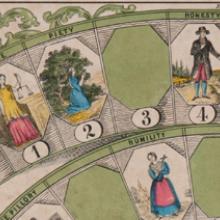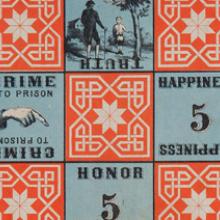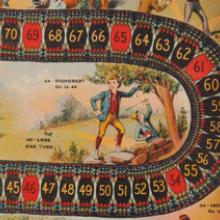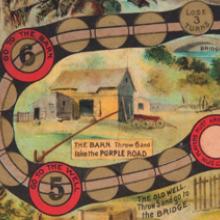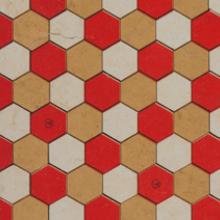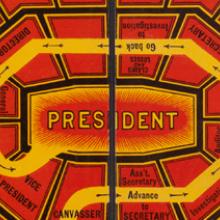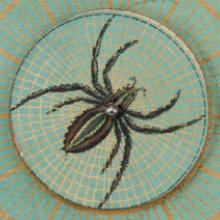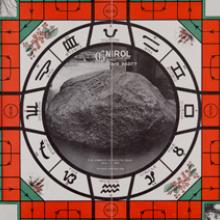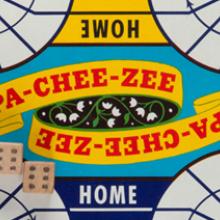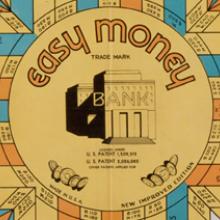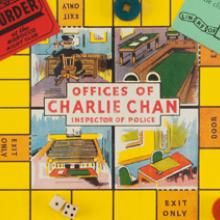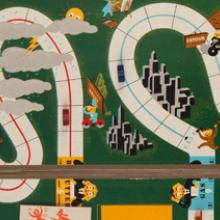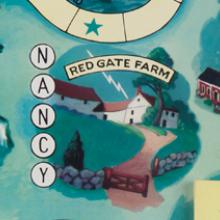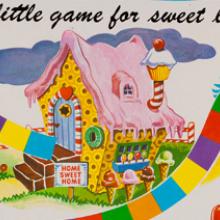Terminal 2














The Mansion of Happiness 1894
Parker Brothers
Salem, Massachusetts
Collection of The Strong, Rochester, New York
107.3309
L2012.1502.003
This is a Parker Brothers’ 1894 reissue of the original Mansion of Happiness released by W. & S. B. Ives in the 1840s. Perhaps the earliest American board game to be mass-produced, it advocates simple, moralistic themes. Idleness leads to poverty and the Sabbath breaker goes straight to the whipping post. In contrast, landing on squares marked piety, chastity, and humility, advances players along the path towards the Mansion of Happiness. Reinforcing moral values was the predominant theme of early board games. These educational games reminded players of the destruction that results from vice and the rewards reaped from living a virtuous life.
The Checkered Game of Life 1866
Milton Bradley
Springfield, Massachusetts
Collection of David Galt, New York, New York
L2012.1501.034
Milton Bradley (1836–1911) opened a lithography business in Springfield, Massachusetts, in 1860. He created The Checkered Game of Life using a standard checkerboard pattern in 1860. Bradley sold 45,000 copies of the game in its first year of production. He also offered game kits during the Civil War for soldiers, which are considered the first commercial “travel” games. By 1868, Milton Bradley was the leading manufacturer of board games in the United States.
The Game of the Sociable Snake c. 1890
McLoughlin Brothers
New York, New York
Collection of The Strong, Rochester, NY
107.3641
L2012.1502.004
The Game of the Sociable Snake is another version of The Game of Goose, an early race game that was played in seventeenth-century Europe and may possibly be traced back to Ancient Egypt. It inspired many other games such as The Mansion of Happiness. Like The Game of Goose, The Game of the Sociable Snake has spaces marked for good behaviors that allow players to advance, while landing on spaces marked for bad behaviors cause players to move backwards.
Lost in the Woods c. 1890
McLoughlin Brothers
New York, New York
Collection of David Galt, New York, New York
L2012.1501.022
The New York-based McLoughlin Brothers was one of the largest American game manufacturers in the nineteenth century. During the 1880s and 1890s, game makers employed the newly introduced chromolithography printing process to produce vibrant board game packaging for games such as Lost in the Woods.
The Yale-Princeton Foot Ball Game 1895
McLoughlin Brothers
New York, New York
Collection of David Galt, New York, New York
L2012.1501.018
Organized and spectator sports became common in the second half of the 1800s, when Americans had more time to pursue leisurely activities. With its origins in rugby, football began sweeping college campuses in the late 1800s. Despite the game’s growing popularity, many colleges and universities banned football from their campuses for several decades due to its rough play and high rate of injury.
Game of the Telegraph Boy 1888
McLoughlin Brothers
New York, New York
Collection of David Galt, New York, New York
L2012.1501.024
Game of the Telegraph Boy was one of many games from the 1880s that depicted the American capitalist dream of Horatio Alger’s novels. In many of his novels, young men rise from rags-to-riches and are rewarded in the workplace based on merit, regardless of their humble backgrounds. The goal of this game is for each player to work one’s way up from low-level employee to company president.
The Game of the Spider and the Bee 1912
Chicago Game Co.
Chicago, Illinois
Collection of David Galt, New York, New York
L2012.1501.030
Although the game play has nothing to do with prizefighting, the game maker depicted an image of a spider and a bee boxing on the cover of this game due to the popularity of the ringside sport at the time of the game’s manufacture. In this game, the bees moving from the hives attempt to travel around the web without being caught by the spinning spider. The player whose bee first travels completely around the web and arrives back in his hive wins the game.
The Pilgrim’s Party 1920
Gnirol Game Co.
Plymouth, Massachusetts
Collection of David Galt, New York, New York
L2012.1501.023
This game commemorates the 300th anniversary of Pilgrims landing in Plymouth, Massachusetts (1620–1920). The name of the game manufacturer, Gnirol, is the founder Walter S. Loring’s last name spelled backwards. Each of the photos on the board depicts a local historic site; Plymouth Rock lies in its center.
Pa-chee-zee: The Game of India c. 1935
All-Fair, Inc.
Rochester, New York
Collection of The Strong, Rochester, New York
108.1566
L2012.1502.008
One of the most widely played games of all time, The Game of India, also known as Pachisi, is the forerunner of Parcheesi and the English game Ludo. Pachisi is the national game of India. England printed its own version of the game in the 1860s, and by the 1870s, it was also produced in the United States. Parcheesi was one of the highest selling games in America, until Parker Brothers released Monopoly in 1935. The Indian version of this game is cross-shaped and is played by four players acting as two teams, unlike Parcheesi, in which each participant plays independently
Easy Money 1936
Milton Bradley
Springfield, Massachusetts
Collection of David Galt, New York, New York
L2012.1501.001
Monopoly 1935, 1946
Parker Brothers
Salem, Massachusetts
Courtesy of Mickey McGowan, San Rafael, California
L2012.1503.005, .006
Monopoly was based on an earlier game, The Landlord’s Game, which was patented by Elizabeth Magie in 1904. The intent of her game was to point out the negative impact of the real estate market and property ownership. Ironically, the later version of the game became a quest to acquire real estate empires. Charles Darrow made changes to the game and attempted to sell his hand-painted version of Monopoly to Parker Brothers who initially rejected his offer. He then began printing up boards and selling the game on his own. The early version came without playing pieces and instructed players to use whatever they had on hand, such as buttons. Parker Brothers eventually agreed to sell the game in 1935. Monopoly’s famous mascot Rich Uncle Pennybags first graced the board game’s cover one year later. Since Parker Brothers began producing Monopoly in 1935, more than one billion people have played the game and more than 275 Monopoly board games versions have sold worldwide.
The Great Charlie Chan Detective Mystery Game 1937
Milton Bradley
Springfield, Massachusetts
Collection of David Galt, New York, New York
L2012.1501.003
Charlie Chan, the famous Chinese detective came to life on the pages of six popular novels beginning in 1926. The character, created by Earl Derr Biggers, was loosely based on the Honolulu detective Chang Apana. Charlie Chan was also featured in approximately nearly fifty Hollywood movies. Due to the social climate of the era, Caucasian actors played Chan in the American films. Milton Bradley offered this board game at the height of Charlie Chan’s popularity. Players move from one point to another as directed by the “go” cards. When one player accumulates exactly one hundred links of evidence, they stand revealed as Charlie Chan: The Great Detective, announcing their score and winning the game.
Ration Board Game 1943
Jay-line Mfg. Co. Inc.
Philadelphia, Pennsylvania
Collection of David Galt, New York, New York
L2012.1501.014
This game promoted the rationing of goods during World War II. During the war, rations of common goods were available through the use of government issued cards and booklets, controlled by the ration board. The game board illustration depicts a road winding through the countryside and suburbs into a city where the ration boards are stationed. The first player who returns home with five ration cards for butter, gas, sugar, coffee, and meat wins.
The Nancy Drew Mystery Game 1957
Parker Brothers
Salem, Massachusetts
Courtesy of Mickey McGowan, San Rafael, California
L2012.1503.001
Mysteries have continuously enthralled a variety of audiences, from detective fiction to television and films. Mystery and detective games first began to appear in the late 1800s and enjoyed a golden era in the 1930s. The teen-sleuth Nancy Drew first appeared in a series of books during this decade. The object of this game is to be the first player to discover Nancy Drew’s whereabouts.
Candy Land 1968
Milton Bradley
Springfield, Massachusetts
Courtesy of Mickey McGowan, San Rafael, California
L2012.1503.007
While recuperating from polio, Eleanor Abbott invented the game Candy Land in 1945. She envisioned the game for polio-stricken children to play as they recovered. The game required no reading or mathematical skills so young children could easily play it. Players simply draw a color card or a sweet and advance to that square on the board.
